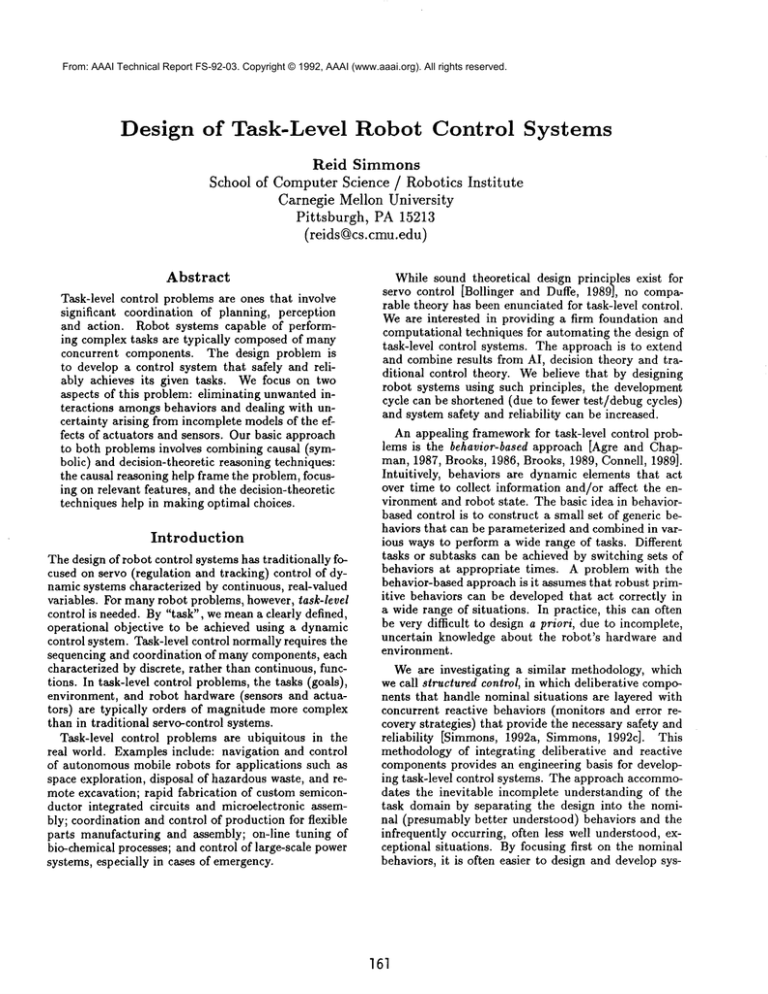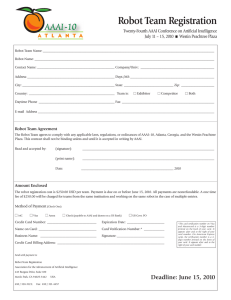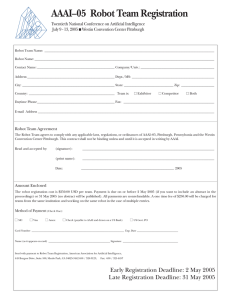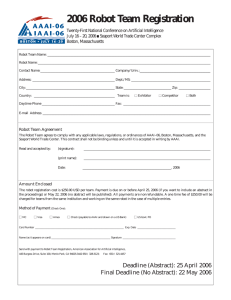
From: AAAI Technical Report FS-92-03. Copyright © 1992, AAAI (www.aaai.org). All rights reserved.
Design
of Task-Level
Robot Control
Reid
Simmons
School of Computer Science / Robotics
Carnegie Mellon University
Pittsburgh,
PA 15213
(reids@cs.cmu.edu)
Abstract
Task-level control problems are ones that involve
significant coordination of planning, perception
and action. Robot systems capable of performing complex tasks are typically composed of many
concurrent components. The design problem is
to develop a control system that safely and reliably achieves its given tasks. We focus on two
aspects of this problem: eliminating unwanted interactions amongs behaviors and dealing with uncertainty arising from incomplete models of the effects of actuators and sensors. Our basic approach
to both problems involves combining causal (symbolic) and decision-theoretic reasoning techniques:
the causal reasoning help frame the problem, focusing on relevant features, and the decision-theoretic
techniques help in making optimal choices.
Introduction
The design of robot control systems has traditionally focused on servo (regulation and tracking) control of dynamic systems characterized by continuous, real-valued
variables. For manyrobot problems, however, task-level
control is needed. By "task", we meana clearly defined,
operational objective to be achieved using a dynamic
control system. Task-level control normally requires the
sequencing and coordination of many components, each
characterized by discrete, rather than continuous, functions. In task-level control problems, the tasks (goals),
environment, and robot hardware (sensors and actuators) are typically orders of magnitude more complex
than in traditional servo-control systems.
Task-level control problems are ubiquitous in the
real world. Examples include: navigation and control
of autonomous mobile robots for applications such as
space exploration, disposal of hazardous waste, and remote excavation; rapid fabrication of custom semiconductor integrated circuits and microelectronic assembly; coordination and control of production for flexible
parts manufacturing and assembly; on-line tuning of
bio-chemical processes; and control of large-scale power
systems, especially in cases of emergency.
Systems
Institute
While sound theoretical design principles exist for
servo control [Bollinger and Duffe, 1989], no comparable theory has been enunciated for task-level control.
Weare interested in providing a firm foundation and
computational techniques for automating the design of
task-level control systems. The approach is to extend
and combine results from AI, decision theory and traditional control theory. Webelieve that by designing
robot systems using such principles, the development
cycle can be shortened (due to fewer test/debug cycles)
and system safety and reliability can be increased.
An appealing framework for task-level control problems is the behavior-based approach [Agre and Chapman, 1987, Brooks, 1986, Brooks, 1989, Connell, 1989].
Intuitively,
behaviors are dynamic elements that act
over time to collect information and/or affect the environment and robot state. The basic idea in behaviorbased control is to construct a small set of generic behaviors that can be parameterized and combined in various ways to perform a wide range of tasks. Different
tasks or subtasks can be achieved by switching sets of
behaviors at appropriate times. A problem with the
behavior-based approach is it assumes that robust primitive behaviors can be developed that act correctly in
a wide range of situations. In practice, this can often
be very difficult to design a priori, due to incomplete,
uncertain knowledge about the robot’s hardware and
environment.
Weare investigating a similar methodology, which
we call structured control, in which deliberative components that handle nominal situations are layered with
concurrent reactive behaviors (monitors and error recovery strategies) that provide the necessary safety and
reliability
[Simmons, 1992a, Simmons, 1992c]. This
methodology of integrating deliberative and reactive
components provides an engineering basis for developing task-level control systems. The approach accommodates the inevitable incomplete understanding of the
task domain by separating the design into the nominal (presumably better understood) behaviors and the
infrequently occurring, often less well understood, exceptional situations. By focusing first on the nominal
behaviors, it is often easier to design and develop sys-
161
From: AAAI Technical Report FS-92-03. Copyright © 1992, AAAI (www.aaai.org). All rights reserved.
tems that operate safely and reliably in the majority of
situations. This separation of nominal and exceptional
behaviors also increases overall system understandability by isolating different concerns: the robot’s behavior
during normal operation is readily apparent, and strategies for handling exceptions can be developed separately
and then layered on to the existing system.
Both behavior-based and structured-control
robot
systems consist of multiple, concurrent componentsacting, sensing and planning (to a greater or lesser extent).
Weare currently investigating two aspects of the design
process for such task-level robot control systems: eliminating unwanted interactions between behaviors, and
increasing system robustness by explicitly taking uncertainty into account.
Handling Interactions
A primary difficulty in developing both behavior-based
and structured-control
systems is that behaviors may
interact in unexpected ways. To ensure that tasks will
be achieved reliably, the designer must detect harmful
interactions and prevent them from occurring. While
interactions are the bane of most design and planning
problems [Simmons, 1992d, Williams, 1991], they are
particularly insidious in robot control problems. This is
due primarily to the high degree of uncertainty in modeling tasks, environments, and robot hardware and to
the real-time aspects of the problem, in particular, the
necessity of having components concurrently planning,
acting and perceiving (monitoring) the environment.
If the behaviors are too tightly coupled, however, it
is very difficult to accurately model all possible interactions. For example, neither the behavior-based nor
structured control approaches are really appropriate for
aircraft-control maneuvers, due to the complexity of the
dynamic interactions [Chiu et al., 1991]. Wewill limit
our investigations, therefore, to domainswhere the system components, while not independent, are still coupled loosely enough to make the modeling and reasoning
problems tractable.
Such domains include autonomous
mobile robots, process plant control, and many manufacturing operations.
We are extending transformational
planning techniques, originally developed for debugging faulty plans
[McDermott, 1991, Simmons, 1988, Simmons, 1992d],
to deal with interactions in task-level control systems.
These techniques use symbolic projection/simulation
algorithms to construct causal explanations that describe how, when and why interactions
between components (and between the robot and its environment)
occur. The planning/debugging techniques analyze the
causal explanations to suggest modifications that will
eliminate the interactions. Such modifications may involve 1) constraining existing behaviors (e.g., limiting
the maximum
robot velocity), 2) constraining pair-wise
interactions (e.g., sequencing behaviors that were concurrent, or adding resource prioritization constraints),
and 3) adding new components (e.g., adding a behav-
ior that removes excess heat caused by mixing chemical
reagents in a process plant).
For example, suppose a mobile robot is tasked with
delivering objects, keeping the laboratory neat, and
maintaining its battery charge. These tasks may arise
asynchronously, and the robot system must decide how
to prioritize the tasks to avoid resource contention.
Rather than using a heuristic or static prioritization
scheme, the system can analyze the causal connections
between the action preconditions, the system goals (to
determine the purposes of the actions) and assumptions
underlying the tasks to determine which ordering of
tasks is most cost effective. Similar analyses can determine which actions must be taken to transition between tasks effectively (such as setting objects downor
fetching particular tools). This is the basis of the work
reported in [Goodwin and Simmons, 1992], in which a
classical planning algorithm generates alternative plans
of action, which are then analyzed according to economic criteria to find the optimal ordering of tasks. In
this case, the combination of causal reasoning (planning) and decision-theoretic reasoning (economic analysis) yielded results that neither alone could support.
A major problem in reasoning about interactions is
modeling systems with the necessary degree of fidelity,
while not making them so complex as to be computationally infeasible. Weare investigating the use of
the MIDASsimulation package [Simmons, 1991], which
integrates multiple representations and reasoning techniques, to model systems and to provide causal explanations for how they behave. MIDASfacilitates
the
modeling of causal, temporal and spatial aspects of the
robot’s environment and hardware at various degrees
of abstraction (qualitative, semi-quantitative, discrete,
and continuous). At this point, we are just beginning
to create such models and to determine how the modeling framework must be extended to handle the design
of complex robot control systems.
While symbolic, causal reasoning can detect many
interactions, it models behaviors at too coarse a level
of abstraction to guarantee the reliability of the control
system. We intend to augment such reasoning with
rigorous quantitative analysis to provide such guarantees. The analysis would be based on algorithms
that perform interval-based analyses of control systems
modeled as hybrid discrete/continuous networks of behaviors. The basic idea is to propagate the ranges
of state variables and event times through the networks and analyze the resulting overlap between various intervals. This approach would essentially extend
the control-theoretic algorithms developed for uncertainty propagation and state estimation in continuous
dynamic systems with bounded uncertainty (e.g., [Milanese and Belforte, 1982]). It is expected that the
semi-quantitative arithmetic reasoning capabilities of
MIDAS
(which incorporates the Quantity Lattice [Simmons, 1986]) will be well-suited to this reasoning task.
162
From: AAAI Technical Report FS-92-03. Copyright © 1992, AAAI (www.aaai.org). All rights reserved.
Dealing
With Uncertainty
The other aspect of the design problem we are interested in involves reasoning about the uncertainty in
one’s model of the system. In general, there is significant unpredictability
about how a complex robot
system will behave, due to incomplete understanding of the effects of actuators and sensors in the real
world. Typically, however, the uncertainty in the models can be bounded. In such cases, the control system
can often be made more robust by explicitly taking
the uncertainty into account [Dean and others, 1990,
Kosaka and Kak, 1992, Lozano-Perez et al., 1984].
For example, if one wants a mobile robot to avoid
hitting walls, it is more reliable to have it travel in
the center of free space, rather than trying to hug the
walls. This often conflicts with other goals, such as minimizing travel distance or maintaining accurate knowledge of the robot’s current position. In such cases,
decision-theoretic techniques are often useful for choosing amongst the various options [Dean et al., 1990].
In a similar vein, we are interested in designing taskspecific, selective perception strategies in which the expected cost of sensing is weighed against the expected
gain in information [Chrisman, 1992b, Chrisman and
Simmons, 1991, Simmons, 1992b]. Sophisticated robot
control systems need selective perception for several
reasons. First, the number and bandwidth of sensors
are limited, but the amount of information potentially
available is essentially unlimited. Thus, some method
is needed for controlling the information flow. Second,
in somesituations it is, in fact, more cost-effective to
blindly execute a sequence of actions that each have a
relatively high probability of success, rather than sensing after every action [Chrisman and Simmons, 1991].
In such situations, selective perception can actually
make the system more reliable.
The difficulty is in comparingthe various options: determining what is and whenit is cost effective to sense.
Here again, we expect a combination of causal and
decision-theoretic reasoning to be useful. The decisiontheoretic reasoning would be used to analyze how sensitive plans are to uncertainty in the environment and
action outcomes, howwell a particular source of information correlates with the potential success or failure
of achieving a goal, etc. Decision-theoretic techniques
are computationally quite complex, however, so it is
important to focus the reasoning on relevant features
of the problem. This is the role for causal, symbolic
reasoning: it can frame the decision-theoretic problem
by pinpointing the important aspects to consider, abstracting awayirrelevant details.
The basic idea is to derive causal dependencystructures relating the goals (and preconditions) of plans
underlying state variables and parameters of actions.
The dependencies then form a framework for focusing
the decision-theoretic analysis.
Weare investigating a combination of analytical and
numeric (Monte Carlo) techniques for characterizing
the uncertainty in, and expected cost of, conditional
plans. These techniques are used to propagate uncertainty (both symbolic and numerical probability distributions) through the dependency structures (this technique has similarities to the interval-based propagation
described in the previous section). Where the variance
between the predicted and desired states of the world
gets too large, it is an indication that sensing operations
maybe needed to reduce the variance to acceptable levels. Such decisions about when to sense can often be
madeat design time. In addition, if the sensing operations are parameterized (such as the direction to point
a camera or the sensor resolution to use), this technique can be used to optimize the choice of parameters
[Simmons, 1992b].
Suppose, for instance, that a mobile robot has the
task of picking up various objects. Due to inaccuracies in its arm and gripper, it must be positioned fairly
accurately with respect to an object in order to grasp
it successfully. In this case, the definition of "fairly
accurately" is very muchdependent on the characteristics of the arm and gripper, as well as the relative size
of the object, and the uncertainty in the robot’s position with respect to that object. Using these analytical
techniques, one can determine that for small enough objects, it is optimal for the robot to sense (and correct)
its position relative to the object before attempting to
pick it up. While the choice of what constitutes "small
enough," or at what resolution to sense, really depends
on the precise uncertainties involved, the framework
of the Solution is applicable across robots and objects.
Also, while this particular approach relies on an accurate specification of the uncertainty (in terms of probability distribution functions), we believe that it can
be adapted to more general models of belief [Chrisman,
1992a].
Conclusions
Wehave presented several problems relating to the design of task-level robot control systems. These problems stem mainly from interactions between concurrent
components and from uncertainty in modeling the system. To address these problems, we advocate using
a combination of causal and decision-theoretic reasoning: causal reasoning to focus on relevant aspects of the
problem and decision-theoretic reasoning to provide optimal solutions.
Our investigations into designing task-level control
problems is just beginning, and it is really too early to
know whether useful design tools will emerge. First,
it is unclear whether the models of the robot’s tasks,
environment and hardware can be developed that are
tractable, yet provide the necessary information to reason about interactions and uncertainty. Second, it is
unclear just how much leverage the causal, symbolic
reasoning will provide, and how dependent we will be
on more traditional, numeric analysis methods.
Webelieve, however, that fundamental problems in
163
From: AAAI Technical Report FS-92-03. Copyright © 1992, AAAI (www.aaai.org). All rights reserved.
reasoning about uncertainty and interactions between
behaviors can be tackled using techniques such as those
outlined above. The hope is that this will result in
principled design techniques for constructing safe and
reliable robot control systems.
Acknowledgments
Many thanks to Lonnie Chrisman and Richard Goodwin for their ideas, discussions and implementations.
This research is supported by NASAunder Contract
NAGW-1175.
References
[Agre and Chapman, 1987] Phil Agre and David Chapman. Pengi: An implementation of a theory of activity. In Proc. National Conference on Artificial Intelligence, pages 268-272, Seattle, WA,1987.
[Bollinger and Duffe, 1989] John G. Bollinger and
Neil A. Duffe. Computer Control of Machines and
Processes. Addison-Wesley Publishing Company,
1989.
[Brooks, 1986] Rodney Brooks. A robust layered control system for a mobile robot. IEEE Journal of
Robotics and Automation, RA-2(1), 1986.
[Brooks, 1989] Rodney Brooks. A robot that walks:
Emergent behavior from a carefully evolved network.
Neural Computation, 1(2):253-262, Summer1989.
[Chiu et al., 1991] S. Chiu, S. Chand, D. Moore, and
A. Chaudhary. Fuzzy logic for control of roll and
momentfor a flexible wing aircraft.
IEEE Control
Systems Magazine, 11(4):42-48, June 1991.
[Chrisman and Simmons, 1991] Lonnie Chrisman and
Reid Simmons. Sensible planning: Focusing perceptual attention. In Proc. National Conference on Artificial Intelligence, pages 756-761, Los Angeles, CA,
July 1991.
[Chrisman, 1992a] Lonnie Chrisman. Abstract probabilistic modeling of action. In First International
Conference on AI Planning Systems, College Park,
MD, June 1992.
[Chrisman, 1992b] Lonnie Chrisman. Planning for
closed-loop execution using partially observable
markovian decision processes. In AAAI Spring Symposium on Selective Perception, Stanford, CA, March
1992.
[Connell, 1989] John Connell. A behavior-based arm
controller.
IEEE Journal of Robotics and Automation, 5(6):784-791, 1989.
[Dean and others, 1990] TomDean et al. Coping with
uncertainty in a control system for navigation and exploration. In Proc. National Conference on Artificial
Intelligence, pages 1010-1015, Boston, MA,1990.
[Dean et al., 1990] Thomas Dean, Kenneth Basye, and
Moises Lejter. Planning and active perception. In
Proceedings of the DARPAWorkshop on Innovative
Approaches to Planning, Scheduling, and Control,
pages 271-276. DARPA,1990.
[Goodwin and Simmons, 1992] Richard Goodwin and
Reid Simmons. Rational handling of multiple goals
for mobile robots. In First International Conference
on AI Planning Systems, College Park, MD, June
1992.
[Kosaka and Kak, 1992] Akio Kosaka and Avi Kak.
Fast vision-guided mobile robot navigation using
model-based reasoning and prediction of uncertainties. In Proc. IEEE International Workshopon Intelligent Robots and Systems, pages 2177-2186, Raleigh,
NC, July 1992.
[Lozano-Perez et al., 1984] Tomas
Lozano-Perez,
Matthew Mason, and Russell Taylor. Automatic synthesis of fine-motion strategies for robots. International Journal of Robotics Research, 3(1), 1984.
Regression
[McDermott, 1991JDrew McDermott.
planning. International Journal of Intelligent Systems, 6:357-416, 1991.
[Milanese and Belforte, 1982]
M. Milanese and G. Belforte. Estimation theory and
uncertainty intervals evaluation in the presence of unknownbut bounded errors: Linear families of models
and estimators. IEEE Trans. on Automatic Control,
27:408-414, 1982.
[Simmons, 1986] Reid Simmons. Commonsense arithmetic reasoning. In Proc. AAAI-86, pages 118-124,
Philadelphia, PA, August 1986.
[Simmons, 1988] Reid Simmons. A theory of debugging
plans and interpretations.
In Proc. AAAI-88, pages
94-99, St. Paul, MN, August 1988.
[Simmons, 1991] Reid Simmons. Integrating multiple
representations for incremental, causal simulation. In
Proc. Conference on AL Simulation, and Planning,
pages 88-96, Cocoa Beach, FL, April 1991.
[Simmons, 1992a] Reid Simmons. Concurrent planning
and execution for autonomous robots. IEEE Control
Systems, 12(1):46-50, February 1992.
[Simmons, 1992b] Reid Simmons. Determining sensing
resolution and frequency. In AAAI Spring Symposium on Selective Perception, Stanford, CA, March
1992.
[Simmons, 1992c] Reid Simmons. Monitoring and error
recovery for autonomous walking. In Proc. IEEE International Workshopon Intelligent Robots and Systems, pages 1407-1412, July 1992.
[Simmons, 1992d] Reid Simmons. The roles of associational and causal reasoning in problem solving. Artificial Intelligence, 53(2-3):159-208, February 1992.
[Williams, 1991] Brian Williams. A theory of interactions: Unifying qualitative and quantitative algebraic
reasoning. Artificial Intelligence, 51(1-3):39-94, October 1991.
164





